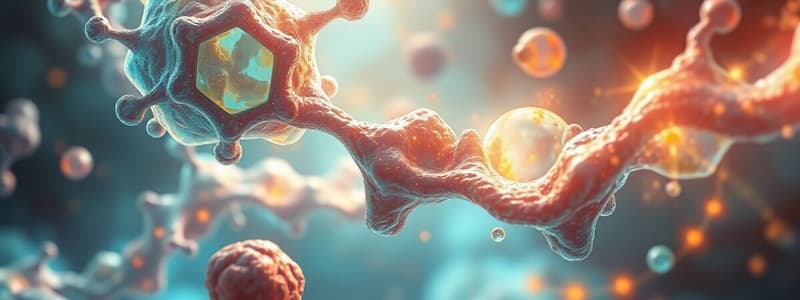Podcast
Questions and Answers
What is the primary function of enzymes in biological reactions?
What is the primary function of enzymes in biological reactions?
- To increase the activation energy
- To eliminate reactants from the reaction
- To change the temperature of the reaction
- To decrease the activation energy (correct)
Which of the following statements about enzymes is NOT true?
Which of the following statements about enzymes is NOT true?
- Enzymes are consumed in reactions (correct)
- Enzymes can be denatured
- Enzymes are usually proteins
- Enzymes require cofactors for activity
How are enzymes typically named?
How are enzymes typically named?
- Based on their size and structure
- Using random numerical codes
- According to their substrate and function (correct)
- By the temperature at which they work best
What term is used to describe the substances that enzymes act upon?
What term is used to describe the substances that enzymes act upon?
What suffix is commonly added to the names of enzymes that act on specific substrates?
What suffix is commonly added to the names of enzymes that act on specific substrates?
What is the primary function of oxidoreductases?
What is the primary function of oxidoreductases?
Which type of enzyme is primarily responsible for hydrolysis reactions?
Which type of enzyme is primarily responsible for hydrolysis reactions?
How does the active site of an enzyme relate to its substrate?
How does the active site of an enzyme relate to its substrate?
What occurs when an enzyme binds to its substrate?
What occurs when an enzyme binds to its substrate?
What model describes the precise fit of the substrate into the enzyme's active site?
What model describes the precise fit of the substrate into the enzyme's active site?
Which class of enzymes is involved in forming bonds by condensation reactions coupled with ATP cleavage?
Which class of enzymes is involved in forming bonds by condensation reactions coupled with ATP cleavage?
What is the role of coenzymes and prosthetic groups in enzyme action?
What is the role of coenzymes and prosthetic groups in enzyme action?
What is the main change that occurs in the induced fit model of enzyme action?
What is the main change that occurs in the induced fit model of enzyme action?
What is a coenzyme?
What is a coenzyme?
What happens to enzyme activity as the temperature increases?
What happens to enzyme activity as the temperature increases?
What is the effect of substrate concentration on enzyme activity?
What is the effect of substrate concentration on enzyme activity?
What is the role of covalent modification on enzyme activity?
What is the role of covalent modification on enzyme activity?
Which of the following descriptions apply to zymogens?
Which of the following descriptions apply to zymogens?
What is the optimum pH range for pepsin?
What is the optimum pH range for pepsin?
According to the Michaelis-Menten model, what occurs at low substrate concentration?
According to the Michaelis-Menten model, what occurs at low substrate concentration?
Which of the following metal ions is NOT listed as an activator for enzymes?
Which of the following metal ions is NOT listed as an activator for enzymes?
What happens to the velocity of an enzyme-catalyzed reaction at high substrate concentrations?
What happens to the velocity of an enzyme-catalyzed reaction at high substrate concentrations?
What does the Michaelis constant (KM) represent?
What does the Michaelis constant (KM) represent?
How do competitive inhibitors affect the Michaelis-Menten curve?
How do competitive inhibitors affect the Michaelis-Menten curve?
What is the result of enzyme regulation when substrate levels are low?
What is the result of enzyme regulation when substrate levels are low?
In a Lineweaver-Burk plot for non-competitive inhibition, what is observed?
In a Lineweaver-Burk plot for non-competitive inhibition, what is observed?
What role does feedback control play in enzyme regulation?
What role does feedback control play in enzyme regulation?
Why are proenzymes produced in their inactive form?
Why are proenzymes produced in their inactive form?
What characterizes a hyperbolic curve in enzyme kinetics?
What characterizes a hyperbolic curve in enzyme kinetics?
What happens when a regulator binds to an allosteric enzyme?
What happens when a regulator binds to an allosteric enzyme?
Which condition results in the maximum velocity (Vmax) in an enzyme-catalyzed reaction?
Which condition results in the maximum velocity (Vmax) in an enzyme-catalyzed reaction?
Which type of inhibition occurs when a final product inhibits the first enzyme in a series of reactions?
Which type of inhibition occurs when a final product inhibits the first enzyme in a series of reactions?
Why is it inefficient for cells to produce enzymes continuously at low substrate levels?
Why is it inefficient for cells to produce enzymes continuously at low substrate levels?
How is trypsinogen activated from its inactive form?
How is trypsinogen activated from its inactive form?
Which of the following statements correctly defines allosteric regulation?
Which of the following statements correctly defines allosteric regulation?
Which of the following is NOT an example of a proenzyme?
Which of the following is NOT an example of a proenzyme?
What is the function of a regulator in allosteric enzyme regulation?
What is the function of a regulator in allosteric enzyme regulation?
Flashcards are hidden until you start studying
Study Notes
Enzymes
- Biological catalysts that speed up chemical reactions by a factor of 10^6 to 10^12 times
- Most are proteins
- Named after the substrate they act on, ending in '-ase' (e.g., amylase, protease), or '-in' (e.g., pepsin, papain)
Characteristics of Enzymes
- Not consumed in the reaction
- Highly specific, interacting with specific substrates
- Recognize, bind, and modify substrates
- Large molecules composed of amino acid chains linked by peptide bonds
- Can be denatured and precipitated by specific reagents (salts, solvents, etc.)
- May require cofactors (non-protein molecules) for their activity
Classes of Enzymes
- Oxidoreductases: Transfer electrons (hydride ions or H atoms)
- Transferases: Move functional groups between molecules
- Hydrolases: Break down molecules by adding water
- Lyases: Add groups to double bonds, or form double bonds by removing groups
- Isomerases: Rearrange atoms within a molecule to create isomers
- Ligases: Join two molecules together, often using energy from ATP
How Enzymes Work
- Enzymes have specific 3D shapes that fit their substrates
- The active site on the enzyme binds the substrate
- Forms an enzyme-substrate complex, lowering activation energy
- After the reaction, the product is released and the enzyme can bind another substrate
Models of Enzyme Action
- Lock-and-Key Model: Substrate's shape precisely fits the enzyme's active site
- Induced Fit Model: Enzyme changes shape slightly to accommodate the substrate for optimal fit
Active/Inactive Forms of Enzymes
- Apoenzyme: Inactive enzyme without its cofactor
- Coenzyme: Non-protein organic molecule loosely bound to the apoenzyme
- Prosthetic Group: Organic molecule tightly bound to the apoenzyme
- Metal Ion Activator: Inorganic ions that assist in enzyme activity (e.g., K+, Fe2+, Ca2+)
- Zymogen or Proenzyme: Inactive precursor of an enzyme, activated by removing a portion of its polypeptide chain
Factors Affecting Enzyme Activity
- Temperature: Increases reaction rate up to an optimum temperature, then denaturation occurs at higher temperatures
- pH: Enzymes have a specific pH range for optimal activity, outside of which they can denature
- Enzyme Concentration: Higher concentration, faster reaction rate
- Substrate Concentration: Increases reaction rate up to saturation point, where all active sites are occupied
- Covalent Modification: Phosphorylation or methylation can alter enzyme activity
- Inhibition: Competitive, non-competitive, or uncompetitive inhibitors affect enzyme activity
- Allosteric Effects: Regulatory molecules bind to an allosteric site, altering enzyme shape and activity
Enzyme Regulation
- Feedback Control: Products of a reaction pathway can inhibit earlier enzymes in the pathway, preventing overproduction
- Proenzyme Activation: Inactive proenzymes are activated when needed (e.g., trypsinogen to trypsin)
- Allosteric Regulation: Binding of regulatory molecules at allosteric sites can either activate or inhibit enzyme activity
Studying That Suits You
Use AI to generate personalized quizzes and flashcards to suit your learning preferences.





